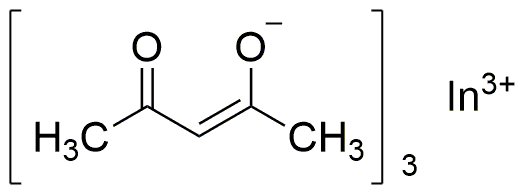Tris(2,4-pentanedionato)indium(III) is widely utilized in research focused on:
- Thin Film Deposition: This compound is commonly used in the fabrication of indium-based thin films for electronic devices, such as transistors and solar cells, enhancing their performance and efficiency.
- Optoelectronic Applications: It plays a crucial role in the development of optoelectronic materials, particularly in light-emitting diodes (LEDs) and laser diodes, due to its excellent luminescent properties.
- Catalysis: In organic synthesis, it serves as a catalyst for various reactions, offering a more efficient and environmentally friendly alternative compared to traditional catalysts.
- Nanotechnology: The compound is utilized in the production of indium oxide nanoparticles, which have applications in sensors, coatings, and advanced materials due to their unique optical and electrical properties.
- Biomedical Research: It is being explored for potential applications in drug delivery systems and imaging agents, leveraging its biocompatibility and ability to interact with biological systems.
General Information
Properties
Safety and Regulations
Applications
Tris(2,4-pentanedionato)indium(III) is widely utilized in research focused on:
- Thin Film Deposition: This compound is commonly used in the fabrication of indium-based thin films for electronic devices, such as transistors and solar cells, enhancing their performance and efficiency.
- Optoelectronic Applications: It plays a crucial role in the development of optoelectronic materials, particularly in light-emitting diodes (LEDs) and laser diodes, due to its excellent luminescent properties.
- Catalysis: In organic synthesis, it serves as a catalyst for various reactions, offering a more efficient and environmentally friendly alternative compared to traditional catalysts.
- Nanotechnology: The compound is utilized in the production of indium oxide nanoparticles, which have applications in sensors, coatings, and advanced materials due to their unique optical and electrical properties.
- Biomedical Research: It is being explored for potential applications in drug delivery systems and imaging agents, leveraging its biocompatibility and ability to interact with biological systems.
Documents
Safety Data Sheets (SDS)
The SDS provides comprehensive safety information on handling, storage, and disposal of the product.
Product Specification (PS)
The PS provides a comprehensive breakdown of the product’s properties, including chemical composition, physical state, purity, and storage requirements. It also details acceptable quality ranges and the product's intended applications.
Certificates of Analysis (COA)
Search for Certificates of Analysis (COA) by entering the products Lot Number. Lot and Batch Numbers can be found on a product’s label following the words ‘Lot’ or ‘Batch’.
*Catalog Number
*Lot Number
Certificates Of Origin (COO)
This COO confirms the country where the product was manufactured, and also details the materials and components used in it and whether it is derived from natural, synthetic, or other specific sources. This certificate may be required for customs, trade, and regulatory compliance.
*Catalog Number
*Lot Number
Safety Data Sheets (SDS)
The SDS provides comprehensive safety information on handling, storage, and disposal of the product.
DownloadProduct Specification (PS)
The PS provides a comprehensive breakdown of the product’s properties, including chemical composition, physical state, purity, and storage requirements. It also details acceptable quality ranges and the product's intended applications.
DownloadCertificates of Analysis (COA)
Search for Certificates of Analysis (COA) by entering the products Lot Number. Lot and Batch Numbers can be found on a product’s label following the words ‘Lot’ or ‘Batch’.
*Catalog Number
*Lot Number
Certificates Of Origin (COO)
This COO confirms the country where the product was manufactured, and also details the materials and components used in it and whether it is derived from natural, synthetic, or other specific sources. This certificate may be required for customs, trade, and regulatory compliance.

